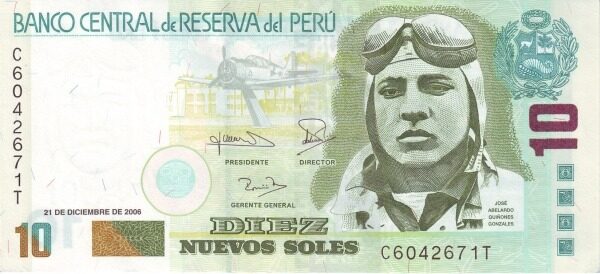Peru banknotes are a colorful representation of the country’s rich cultural heritage, historical figures, and diverse landscapes. Each note features prominent individuals who have shaped Peru’s history, along with images that celebrate the nation’s unique natural and architectural wonders.
The 10-sol note features José Abelardo Quiñones, a heroic Peruvian pilot known for his bravery during World War II. On the back, you’ll find an image of the Hummingbird from the Nazca Lines, one of Peru’s most famous archaeological treasures, symbolizing the country’s deep connection to its ancient past.
The 20-sol note honors Raúl Porras Barrenechea, a well-known historian, diplomat, and teacher. His work contributed to the study of Peru’s history and culture. The reverse side shows the Chavín de Huantar, an important archaeological site that reflects Peru’s ancient civilizations.
The 50-sol note features Abraham Valdelomar, a renowned writer, journalist, and diplomat who played a key role in modern Peruvian literature. On the back, you’ll see the Sacred City of Caral, one of the oldest civilizations in the Americas, showcasing Peru’s rich historical roots.
On the 100-sol note, you’ll find Pedro Ruiz Gallo, an inventor and military engineer celebrated for his contributions to science and technology in Peru. The reverse side highlights the Gran Pajaten, an ancient archaeological site located in the cloud forests, representing Peru’s connection to both nature and history.
The 200-sol note honors Santa Rosa de Lima, the first Catholic saint born in the Americas and a symbol of spiritual devotion in Peru. On the reverse, there is an image of the Machu Picchu Citadel, one of the New Seven Wonders of the World, representing Peru’s incredible architectural achievements and its Incan legacy.
Each Peruvian banknote not only serves a practical purpose but also tells a story, celebrating the country’s heroes, its ancient civilizations, and the stunning landscapes that make Peru such a unique place.
